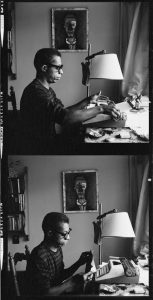Features
It’s the James Baldwin Still Being Relevant for Me
If you were Black in the 1960s, you either joined the Black Panther Party with Malcolm X and Angela Davis as leading figures or The National Association for the Advancement of Colored People (NAACP) joined by Martin Luther King. You may have even become a member of a group like the Student Nonviolent Coordinating Committee (SNCC) led by Stokely Carmichael (Kwame Ture) in 1966 to speak up against

inequality and not shy away from violence.
However, if you were Black in the 1960s and your name was James Baldwin, you were nonconformant toward all three. You would create an alternative lane for activism, literature and Black existence that would outlive most Black Power movements and still be prevalent today.
“I am saying that a journey is called that because you cannot know what you will discover on the journey, what you will do with what you find, or what you find will do to you.”
Baldwin said this because although he identified differently than most of the individuals in the Black Power Movement, he knew he had to pay his dues to his “neighbor” and be vocal about his community. He needed to get their stories out.
Baldwin on Finding Identity
Although he felt a responsibility to the Black community, Baldwin didn’t join all Black practices. One of which was the Black Panthers, he didn’t agree with all of their beliefs and tactics.
“I was not, for example, a Black Muslim, in the same way, though for different reasons, that I never become Black Panther. Because I did not believe that all white people were devils,” said Baldwin.
Nor did he affiliate with any religious institutions. He often referred to religion as a hiding place, where people are panic-stricken.
“I was not a member of any Christain congregation because I knew that they had not heard and did not live by the commandment, ‘Love one another as I love you,” said Baldwin.
And being a devout member of any civil rights organization was also out of the question.
Balwin said, “I was not a member of the NAACP because, in the north, where I grew up, the NAACP was fatally entangled with Black class distinctions…which repelled a shoe-shine boy like me.”
Instead of joining a system and forcing himself to fit into a mold or facing probable rejection, he made himself a cultural curator and gatekeeper. Baldwin became a channel that told stories about Black injustice, but also tales about identity, humility and love.
Baldwin on Agency & Accountability
Baldwin represents a travel icon of sorts for Black people. He wasn’t just an unhappy Black American. He was an unhappy Black American with the agency to leave. Baldwin left for Paris, France to become a successful writer. He said he only existed in the guilt of white people, but he wanted to exist as an individual.
“If you’re not French in France, you don’t exist. And that’s what I needed,” said Baldwin.
During that time, he would rather be invisible than to be acknowledged only because of racism.
In light of that, some of the biggest lessons that he’s left us with today are the power of choice and the importance of accountability—specifically in terms of racists and him having ”to be Black in order to justify my slavery.”
In a 1968 interview on The Dick Cavett Show, Cavett inquired about Black progress in America. He spoke about Black people acquiring political positions, being powerhouses on sports teams and even starring in commercials. Do these accolades give an inkling of progress or hope? He asked Baldwin the question of whether or not things are getting better for Black people.
Baldwin laughed before responding.
“It’s not a question of what happens to the negro here or the Black man here. The real question is: ‘what’s going to happen to this country?’
Baldwin on History Repeating Itself
Many people make those same arguments of Black success to try and exemplify that the world has somehow completely eradicated racism. However, what Baldwin said in his essay titled The White Man’s Guilt arguably holds today. He said that color is a disagreeable mirror for white people. Disagreeable because a lot of energy goes into reassuring white people they do not see what they see.
But, they know what they see, what they saw then and what they see now— “an appallingly oppressive and bloody history.” Baldwin says in the essay that instead of acknowledging such history, they’ve readied themselves to defend against charges that the mirror of color hasn’t even accused them of.
Everyone can take from that excerpt and apply it to today. White guilt still holds progress at gunpoint. Black people are not expecting or accusing the white people of today to be held responsible for slavery. They are asking them to acknowledge the lasting impacts that slavery created— which they benefit from. However, Black people are still seen as disagreeable mirrors and have to, unfortunately, make do with little agency they have to survive.
“We’ve made a legend out of a massacre,” said Baldwin




Pingback: 5 Ways to Help Your Child Choose a Fulfilling Career - InClub Magazine